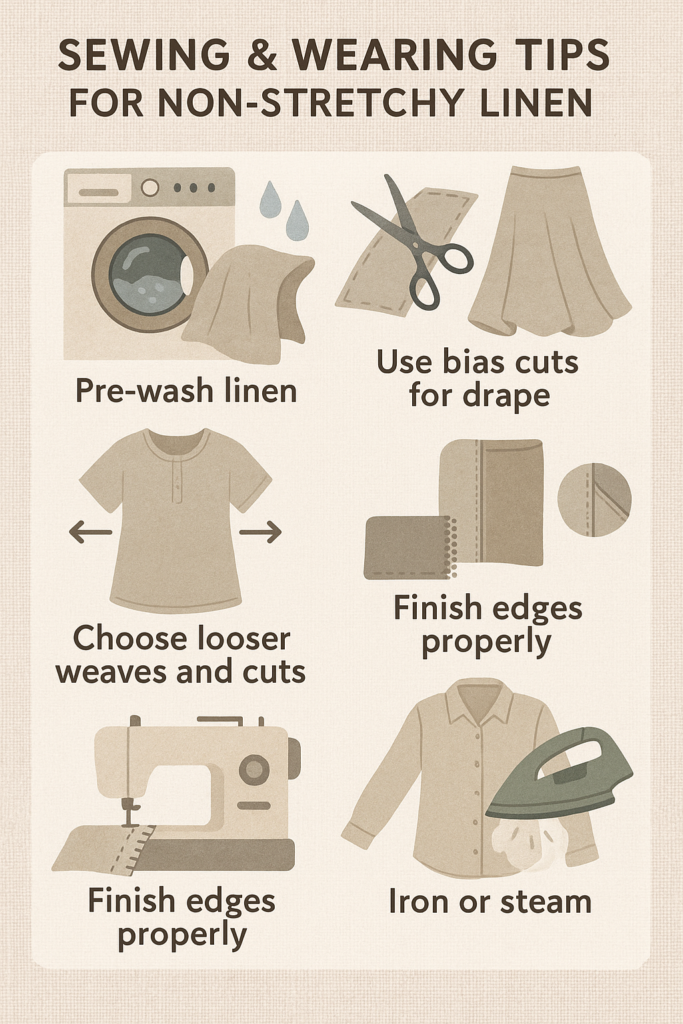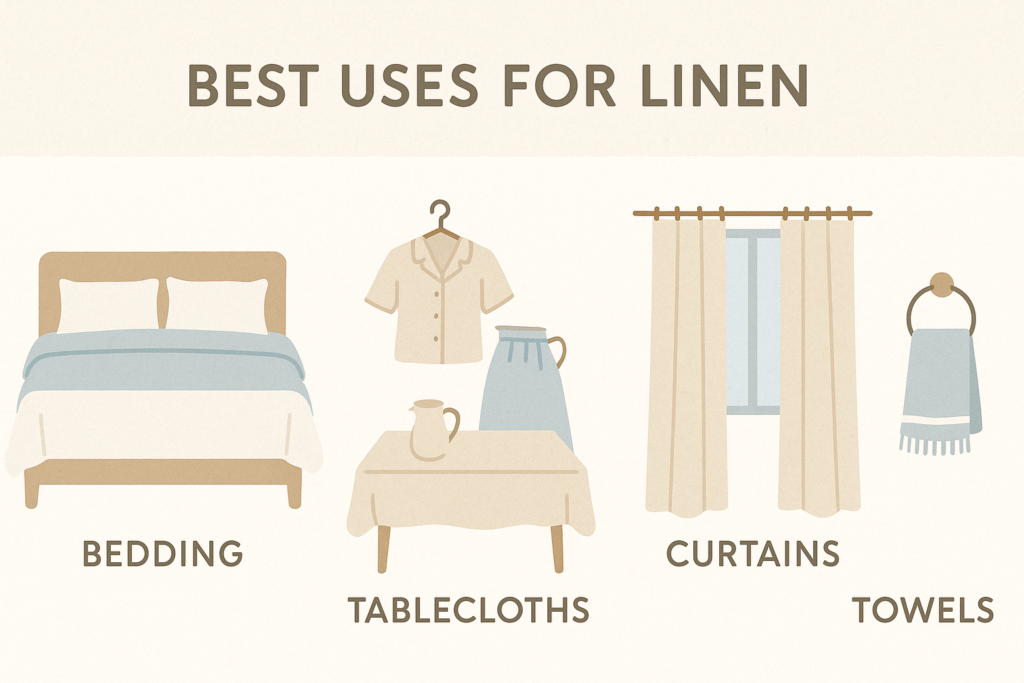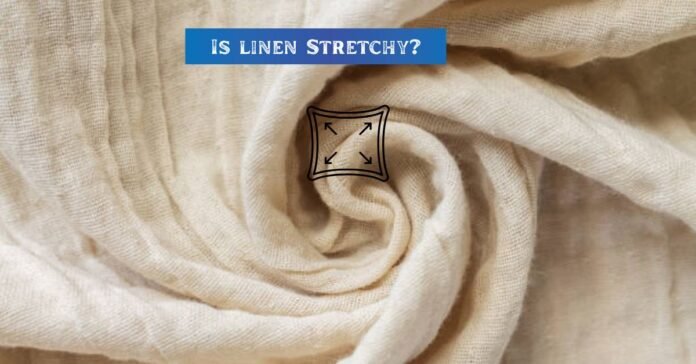Introduction
Is linen stretchy? No, linen is not naturally stretchy. That’s the honest and straightforward answer. People often wonder about linen’s flexibility because they want comfortable, well-fitting clothing. They may also be concerned about fit when sewing. Some think linen might relax or loosen with wear. For example, linen’s flax fibers are inherently more rigid and less elastic than cotton. As a result, pure linen fabric holds its shape firmly. Unlike stretchy knits or spandex blends, linen will not expand on the body. Instead, linen drapes nicely but stays essentially the same size unless physically altered. In sewing, many note that linen won’t ease out tight seams as a knit will. Understanding this helps avoid surprises when fitting or tailoring linen garments.
Why Linen Isn’t Stretchy (Fiber Structure)
Linen’s fibers come from the flax plant and are naturally straight and stiff. Unlike wool (which has natural crimps and give), linen fibers are smooth and straight. The fabric has no elastic recoil. Flax fibers contain a high degree of crystalline structure, making linen inherently rigid. In practical terms, linen feels firm and has low elasticity. This means it resists stretching. In fact, flax fibers are about 30% stronger than cotton. This makes linen very durable, but also less flexible. By contrast, cotton or wool fibers have more natural give and bounce back after stretching. Thus linen stays sturdy and doesn’t stretch out of shape.
Does Linen Loosen Over Time?
Linen tends to soften and drape more after wearing and washing. However, it does not truly loosen or grow bigger. Instead, linen often undergoes a slight relaxation shrinkage in the wash. For example, linen fabric may shrink about 3–4% after the first wash. This happens because the flax fibers relax, rather than stretch out. In fact, wet linen actually gets stronger. Thus it holds its shape. In other words, well-worn linen garments become more supple and comfortable, not larger. Linen also wrinkles easily, so a garment may look baggy from creasing even though the fabric itself hasn’t stretched. Over time, your linen outfit will remain true to size. Any extra ease comes from fiber softening, not stretch.
Blended Linen Fabrics
When a little stretch is needed, many manufacturers blend linen with other fibers. Even a small percentage of elastane (spandex) in linen creates a “stretch linen” fabric. This can give form-fitting clothing more flexibility. These blends keep linen’s natural look and breathability, but add some give. For example, some fabrics labeled “linen with 2% spandex” allow more movement. A fitted dress or trousers made from such a blend will move with you. In practice, stretch-linen fabrics let you bend and sit more easily than 100% linen would. Designers often use these for travel-wear or suits where a little ease is important without sacrificing linen’s classic look. For travel or long days out, that small stretch makes a big difference in comfort.
Another common blend is linen with cotton. Cotton-linen blends feel softer and drape better than pure linen. In fact, linen has less elasticity than cotton or linen-cotton blends. As a result, a linen-cotton blend fabric is noticeably softer and more forgiving than pure linen. These blends still breathe well and look like linen, but they offer extra comfort. For example, many summer shirts and dresses use linen-cotton blends for extra softness and ease of care. These blends wash similar to cotton and require similar sewing techniques.
Linen + Spandex/Elastane: Adds Stretch
Mixing linen with spandex (elastane) makes it stretchy. Even 1–3% elastane can yield a noticeably more flexible fabric. This stretch linen is ideal for close-fitting garments like jackets, trousers, or sheath dresses. The added stretch offers increased comfort and recovery – the fabric bounces back rather than sagging. Essentially, linen-elastane blends give you the look of linen with some of the give of a knit. For example, these small amounts of stretch translate to greater ease of movement. If you want linen that moves with you, look for blends labeled with a bit of elastane.
Linen + Cotton: Slightly More Flexible Than Pure Linen
A linen-cotton blend softens linen’s stiffness. Cotton’s smooth fibers counteract linen’s coarseness, so the blend feels gentler. This mixture still drapes with linen’s coolness, but it resists wrinkles a bit better. It doesn’t stretch like a knit, yet it is more forgiving on the body than pure linen. Cotton-linen fabrics (such as 55% linen/45% cotton) are popular for summer dresses, shirts, and table linens. They let air circulate and feel soft, while retaining much of linen’s natural texture. In fact, many summer dresses use a 50/50 linen-cotton blend for a lighter, softer feel. In sewing, treat these blends like a medium-weight cotton fabric.
Does Linen Stretch When You Wear It?
Wearing a linen garment will not make it grow. Linen is a woven fabric, not a knit. As one sewing guide notes, a woven textile will “not bounce back to shape like a knit”. This means your linen shirt or pants will hold their cut and size during normal wear. Any extra ease from movement comes only if the fabric is designed with stretch (like adding spandex or cutting on the bias). On a hot day, your linen blouse won’t suddenly loosen – it remains firm. In short, wearing linen will not cause it to stretch out over time; the fabric stays much like the day you put it on.
Stretchy Fabrics vs. Linen
Fabrics with real stretch are typically knits or have elastic fibers. Knits (like jersey, rib, or fleece) are looped, so they can expand and recover. Woven fabrics like linen use straight threads, giving them little inherent give. In practical terms, think of stretchy yoga pants versus a linen suit. Yoga pants conform and spring back; a linen suit stays as cut. The key difference is construction: a woven will wrinkle and stay misshapen when pulled, whereas a knit bounces back. Activewear fabrics often include spandex for four-way stretch, which plain linen lacks. Ultimately, knits and spandex blends offer a flexibility that linen alone never will. So if you need ease of movement, choose those instead of 100% linen.
Does Linen Have Elasticity
Linen has very low elasticity — essentially none. One expert source bluntly states, “Linen has poor elasticity — flax fibers do not stretch.”. In practical terms, this means pure linen fabric will not expand on the body or spring back. Instead, linen stays the size you cut it and will wrinkle under strain. For instance, if a sewing pattern calls for a 36-inch bust, cutting your linen to that exact measurement is wise — it won’t magically expand with wear. Compared to a stretchy knit or cotton jersey, linen’s give is negligible. In sewing, always assume zero stretch. Any ease must come from the garment’s cut, not the linen fiber.
Sewing & Wearing Tips for Non-Stretchy Linen
To work with linen’s lack of stretch, try these tips:
- Pre-wash linen: Always wash your linen fabric before cutting or sewing. Pre-washing removes finishes and gets most shrinkage out, so your finished garment won’t unexpectedly shrink later. Use a gentle cycle and lukewarm water, then hang or tumble dry on low. This also softens the linen beforehand.
- Use bias cuts for drape: Cutting garment pieces on the bias (diagonal) gives woven linen a bit of give and a nicer drape. A bias-cut skirt or dress will fall more fluidly and tolerate movement. It’s a simple way to add ease without elastic fibers.
- Choose looser weaves and cuts: Finer, more open linen weaves (like lawn or gauze) drape more than heavy canvas linen. Also design your linen garment with some ease or a relaxed fit (for example, A-line shapes, raglan sleeves, or drawstrings). This accommodates movement without requiring fabric stretch.
- Finish edges properly: Linen frays easily. To prevent unraveling, finish raw edges with a zigzag stitch or serger. You can also use French seams for a neat interior. Press your seams and edges flat for a crisp look; well-pressed linen always looks its best.
- Iron or steam: Linen wrinkles a lot, which can be mistaken for looseness. Iron your linen pieces while slightly damp on a high setting, or use steam. This smooths the fabric and gently relaxes any remaining shrinkage without stretching the fabric.

Common Myths About Linen Stretch
- Myth: “Linen stretches like cotton.” Reality: No, linen has far less give than cotton. Linen’s stiff fibers mean it doesn’t behave like a soft cotton knit. A linen shirt will not stretch out of shape like a jersey top can.
- Myth: “Washing linen will make it stretchy.” Reality: The opposite is true. Washing usually causes linen to shrink slightly. The fibers relax when wet and then tighten upon drying. So laundered linen often ends up the same size or a bit smaller, not larger.
- Myth: “All linen fabrics have some stretch.” Reality: Only linen fabrics blended with elastane or knit can stretch. Pure woven linen (even high-end linen) has negligible stretch. Always check fiber content if you need flexibility.
Best Uses for Linen (When Stretch Matters)
Ideal Uses of Linen
Linen excels in casual, breathable garments. It’s perfect for
- summer shirts
- flowy dresses
- relaxed pants
- tunics
- home items like curtains, tablecloths, or bedding
Linen is lightweight and wicks moisture, so it keeps you cool. In fact, linen “doesn’t cling” to the body, making it flattering and airy in warm weather. Use linen for anything that benefits from a cool, natural fabric with a bit of structure. Its beauty and durability shine when draped rather than stretched.

Avoid Linen For;
Stretch-dependent clothing like tight activewear, swimwear, or bodycon dresses. Since linen has virtually no stretch, it’s not suited to garments that must hug the body under motion. For those items, knit fabrics or synthetic blends with spandex are far better. Save pure linen for pieces where a looser fit is acceptable or even preferred.
Conclusion
In summary, linen isn’t a stretchy fabric at all. Its flax fibers are stiff and strong, so a linen garment will hold its size and only soften or shrink slightly. We’ve seen that linen has minimal elasticity, unlike fabrics blended with spandex. Instead of expecting stretch, it’s best to embrace linen’s strengths: breathability, durability, and lovely drape. For example, a linen blouse can be a perfect summer piece if it’s cut with room through the body. Don’t force linen into a tight mold.
If you love linen, remember to design for its limitations. Try bias cuts, relaxed silhouettes, or blends to add ease. One seamstress quips that linen’s only give comes from a good night’s sleep, not the fabric itself! Ultimately, linen rewards you with cool, effortless style rather than stretch. If you want comfortable linen clothes, opt for relaxed-fit styles or blended fabrics that give some wiggle room while keeping linen’s natural charm.
FAQs
Not really. You can apply steam or a warm iron on damp linen to gently relax wrinkles, but this won’t add true elastic stretch. The fabric will mostly snap back to shape when dry.
No. In fact, wet linen tends to shrink rather than stretch. Linen fibers actually get stronger when moist, and any temporary looseness is lost as the fabric dries. A washed linen garment usually ends up the same size or slightly smaller.
Cotton is more stretchy. Pure linen has very low elasticity, whereas cotton fabrics (especially knits or those with a bit of elastane) have more natural give. So a cotton jersey T-shirt will feel more flexible than an equivalent linen shirt.
